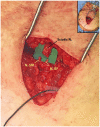Targeted muscle reinnervation for the management of pain in the setting of major limb amputation
- PMID: 32974021
- PMCID: PMC7495925
- DOI: 10.1177/2050312120959180
Targeted muscle reinnervation for the management of pain in the setting of major limb amputation
Abstract
The life altering nature of major limb amputations may be further complicated by neuroma formation in up to 60% of the estimated 2 million major limb amputees in the United States. This can be a source of pain and functional limitation of the residual limb. Pain associated with neuromas may limit prosthetic limb use, require reoperation, lead to opioid dependence, and dramatically reduce quality of life. A number of management options have been described including excision alone, excision with repair, excision with transposition, and targeted muscle reinnervation. Targeted muscle reinnervation has been shown to reduce phantom limb and neuroma pain for patients with upper and lower extremity amputations. It may be performed at the time of initial amputation to prevent pain development or secondarily for the treatment of established pain. Encouraging outcomes have been reported, and targeted muscle reinnervation is emerging as a leading surgical technique for pain prevention in patients undergoing major limb amputations and pain management in patients with pre-existing amputations.
Keywords: Neuroma; TMR; amputation; chronic pain; nerve; nerve transfer; neuroma; pain; phantom limb pain; residual limb pain; stump pain.
© The Author(s) 2020.
Conflict of interest statement
Declaration of conflicting interests: The author(s) declared no potential conflicts of interest with respect to the research, authorship, and/or publication of this article.
Figures


References
-
- Rauck RL, Cohen SP, Gilmore CA, et al. Treatment of post-amputation pain with peripheral nerve stimulation. Neuromodulation 2014; 17: 188–197. - PubMed
-
- Sadosky A, McDermott AM, Brandenburg NA, et al. A review of the epidemiology of painful diabetic peripheral neuropathy, postherpetic neuralgia, and less commonly studied neuropathic pain conditions. Pain Pract 2008; 8(1): 45–56. - PubMed
-
- Pierce RO, Jr, Kernek CB, Ambrose TA., II The plight of the traumatic amputee. Orthopedics 1993; 16: 793–797. - PubMed
-
- Watson J, Gonzalez M, Romero A, et al. Neuromas of the hand and upper extremity. J Hand Surg Am 2010; 35(3): 499–510. - PubMed
-
- Guse DM, Moran SL. Outcomes of the surgical treatment of peripheral neuromas of the hand and forearm: a 25-year comparative outcome study. Ann Plast Surg 2013; 71(6): 654–658. - PubMed
Publication types
LinkOut - more resources
Full Text Sources
Medical

